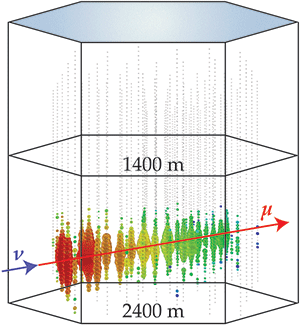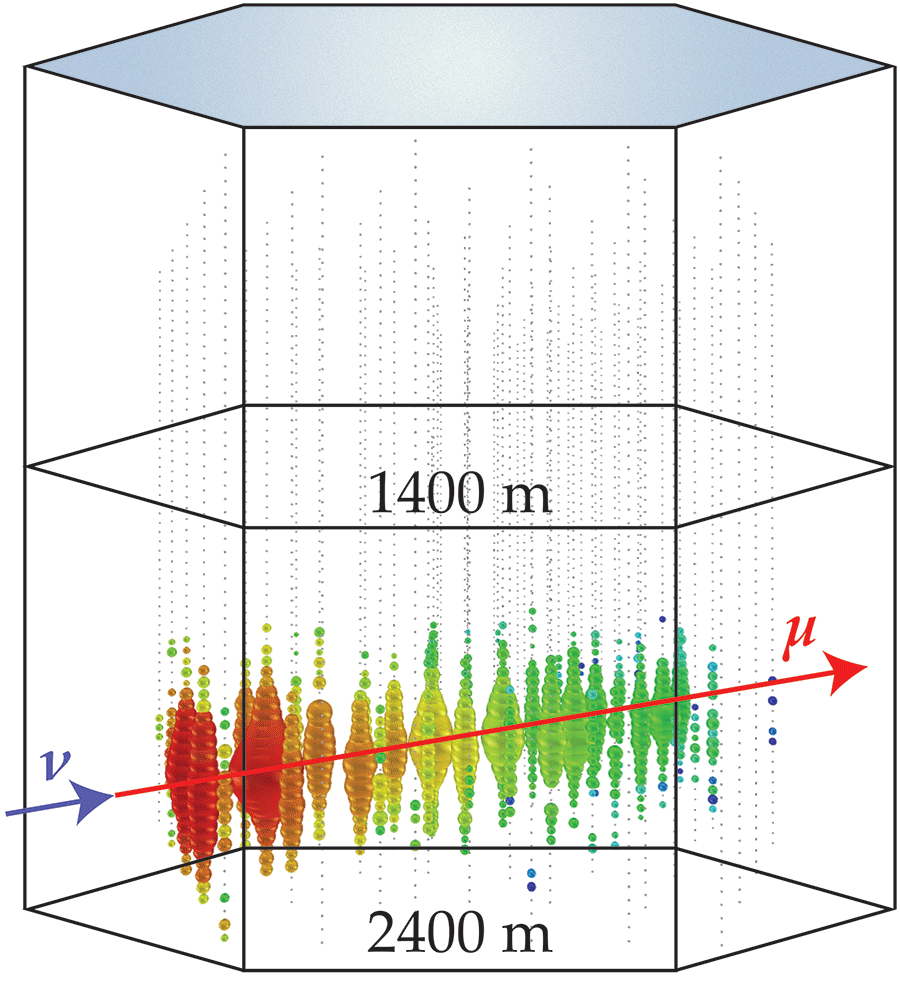The Beginning of Extra-Galactic Neutrino Astronomy
Cosmic rays—the steady shower of high-energy electrons, protons, nuclei, and antiparticles hitting Earth—vary in energy from electron volts (eV) to more than . Scientists have suggested that cosmic rays at energies lower than come from Galactic sources, but no known objects within our Galaxy are capable of accelerating particles to energies beyond [1]. The missing information needed to understand these mysterious, likely extra-Galactic, cosmic accelerators could come from the recent detection of unusually high-energy neutrinos, from electron volts (tera-electron-volt, or TeV) to eV (peta-electron-volt, or PeV), by the IceCube collaboration [2,3], whose latest analysis appears in Physical Review Letters [4]. Although new experiments are needed to confirm that these neutrinos come from the same sources as the highest-energy cosmic rays, IceCube’s signal already points in this direction.
The leading explanation for cosmic-ray particles with energies beyond —known as ultrahigh-energy (UHE) cosmic rays—is that they come from gamma-ray bursts (GRBs) or active Galactic nuclei (AGN). Both objects are powered by the rapid accretion of mass onto black holes, and it is this swirling matter, which produces relativistic jets of particles, that is thought to be a source of cosmic rays. But although GRBs and AGNs are understood on a phenomenological level, constructing a model for the structure of these objects and how they act as “cosmic accelerators” is considered an outstanding goal of astrophysics.
Neutrino “telescopes” are designed to detect neutrinos that potentially come from the same sources that produce high-energy cosmic rays [5]. Neutrinos emerge when protons or nuclei interact with plasma or with a radiation field within or surrounding the source: the interaction produces pions, whose decay produces one electron neutrino and two muon neutrinos. Each neutrino carries of the energy per nucleon of the parent cosmic-ray particle. But unlike charged cosmic rays, chargeless neutrinos are not deflected by magnetic fields on their trajectory to Earth, which provides the advantage that they can be compared to light from the same potential source. And unlike photons, neutrinos can escape from deep within a source, carrying useful information about its physics.
From the observed cosmic-ray flux, and its falloff with energy, we can infer something about the sources of the particles, and hence estimate the flux of neutrinos we can expect to see from the same sources. Above , the cosmic-ray flux is consistent with a cosmological distribution of sources that produce mostly protons at a rate ( ) that is independent of energy ( ): . This “flat” spectrum is a generic prediction of astrophysical acceleration models. Analyses of data from different experiments differ as to the identity of the ultrahigh-energy cosmic rays [1]. But if they are indeed protons—as inferred by some experiments—and assuming that the protons convert all of their energy to pions, an upper bound on the neutrino flux of , known as the Waxman-Bahcall (WB) bound, is obtained [6]. This bound, and the fact that neutrinos interact extremely weakly with matter, implies a detector for neutrinos in the energy range of to has to have a mass of billion tons. A much larger effective mass is required at higher energy.
The IceCube detector achieves a 1 billion ton effective mass by burying photomultiplier detectors in a cubic kilometer of ice in the South Pole. When an electron neutrino collides with an atom in the ice, it generates a broad shower of particles, while muon (tau) neutrinos can generate kilometer-long muon (tau) tracks; both produce light that is detected by the photomultipliers (Fig.1). The detectors can pinpoint the origin of a neutrino to within a degree, based on the direction of its associated track. (The sources of neutrino events that result in showers can only be defined to within tens of degrees.)
In 2013, IceCube reported on two years of data taking, in which they detected neutrinos with energies lying above [3]—including a greater than PeV neutrino that was the highest energy neutrino ever detected [2] (see 8 July 2013 Synopsis). In their latest paper, they have added a third year of data to their analysis, reporting a total of neutrinos with energies lying between and . Their detected signal is significantly ( ) in excess of the expected flux of atmospheric neutrinos (those produced by cosmic rays interacting with atmospheric protons and neutrons) over the same energy.
One clue that the detected neutrinos originate from outside our Galaxy is the isotropy of the neutrino flux. The intensity of neutrinos from extra-Galactic sources is dominated by the furthest observable sources, the distribution of which is expected to be highly homogeneous and isotropic. In contrast, the flux of neutrinos arriving from within our Galaxy is expected to have a strong angular dependence, since Galactic sources are strongly concentrated along the Galactic disk.
The neutrino flux (summed over all neutrino flavors) has an intensity of . The similarity of this value to the WB bound implies that the sources responsible for the neutrino signal produce cosmic rays at a rate . The most likely scenario, and one that is consistent with the IceCube data, is that the sources produce protons with and that those protons with lose most of their energy to pion production [7]. This explanation is consistent with the fact that the IceCube signal contains equal parts of the three neutrino flavors—electron, muon, and tau—the flavor ratio expected from a pion decay ratio, 1:2:0, modified by flavor oscillations over cosmological distances.
The coincidence of the proton cosmic-ray generation rate and spectrum required to account for IceCube’s neutrinos and for UHE cosmic rays, , suggests that both the neutrinos and the UHE cosmic rays are produced by the same sources. However, the required strong energy loss of protons is not expected to take place within GRB or AGN sources. A possible explanation is that protons lose their energy to pions not within the sources, but in the environment surrounding them. In fact, the IceCube signal was predicted to be produced by such a process if the sources reside in starburst galaxies [8]. These galaxies, which are denser and form stars at a much greater rate than our Milky Way, can act as calorimeters (heat absorbers) for protons with energies up to : such protons lose all their energy to pion production after escaping the source that produced them but before escaping the galaxy. The same idea could explain the hint of a suppression in the neutrino flux that IceCube sees above , as protons of energy exceeding may escape the galaxy without producing pions.
This picture predicts a neutrino intensity similar to for , assuming that cosmic-rays are produced predominantly by sources in starburst galaxies [8]. This scenario is plausible for sources whose activity, like that of GRBs, is proportional to the star formation rate, since most of the stars in the Universe have been formed in starbursts.
Ultimately, a better understanding of the sources will require a more accurate measure of the high-energy neutrinos’ flux, spectrum, and flavor ratio. To do so, IceCube will have to expand the effective mass of its detector at . This effort may be assisted by the KM NeT experiment, a few-billion-ton detector planned for construction at the bottom of the Mediterranean Sea [9]. Unfortunately, the angular resolution of both neutrino detectors, which is at best a fraction of a degree (for particle tracks), is still too broad to identify the neutrino sources: With this acceptance angle, the detector window is open to sources from more than galaxies.
One way to identify the sources would be to associate a neutrino with an electromagnetic signal from the same transient event that triggered the particle generation [10]. Here, the idea is to look for those neutrinos produced by cosmic rays interacting within the sources and simultaneously look for light generated by the same event. This type of coincidence experiment is challenging and requires wide-field electromagnetic transient monitoring—such as satellite gamma-ray, x-ray, or UV telescopes—but it would greatly help in the identification of ultrahigh-energy cosmic-ray sources and the study of their physics. It will also enable us to test neutrino properties, such as flavor oscillations and how the particles interact with gravitational fields, with an accuracy many orders of magnitude better than is currently possible.
References
- M. Lemoine, “Acceleration and Propagation of Ultrahigh Energy Cosmic Rays,” J. Phys. Conf. Ser. 409, 012007 (2013)
- M. G. Aartsen and et al., “First Observation of PeV-Energy Neutrinos with IceCube,” Phys. Rev. Lett. 111, 021103 (2013)
- M. G. Aartsen and et al., “Evidence for High-Energy Extraterrestrial Neutrinos at the IceCube Detector,” Science 342, 6161 (2013)
- M. G. Aartsen et al. (IceCube Collaboration), “Observation of High-Energy Astrophysical Neutrinos in Three Years of IceCube Data,” Phys. Rev. Lett. 113, 101101 (2014)
- T. K. Gaisser, F. Halzen, and T. Stanev, “Particle Astrophysics with High Energy Neutrinos,” Phys. Rep. 258, 173 (1995)
- E. Waxman and J. N. Bahcall, “High Energy Neutrinos from Astrophysical Sources: An Upper Bound,” Phys. Rev. D 59, 023002 (1998)
- Sources could generate protons with , but this possibility seems unlikely: it would require a fine tuning in which the protons lose a small enough fraction of their energy to pion production in order to exactly compensate the large production rate of high-energy protons over a wide range of energy
- A. Loeb and E. Waxman, “The Cumulative Background of High Energy Neutrinos from Starburst Galaxies,” J. Cosmol. Astropart. Phys. 5, 3 (2006)
- KM3NeT, “Technical Design Report for a Deep-Sea Research Infrastructure in the Mediterranean Sea Incorporating a Very Large Volume Neutrino Telescope,” http://km3net.org/TDR/TDRKM3NeT.pdf.
- E. Waxman, “IceCube’s Neutrinos: The Beginning of Extra-Galactic Neutrino Astrophysics?,”arXiv:1312.0558





